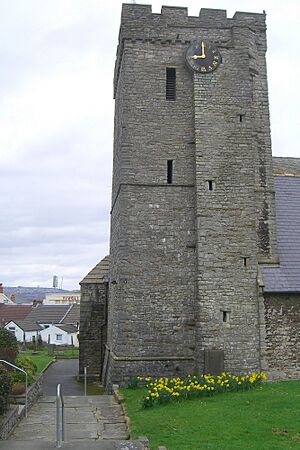All Saints' Church, Oystermouth facts for kids
All Saints' Church, Oystermouth, is a historic church located in Mumbles, a lovely coastal village in South Wales. It's an Anglican church, which means it's part of the Church in Wales, similar to the Church of England. This special building stands on a hillside, not far from the old Oystermouth Castle, and has been an important part of the community for many centuries.
Contents
History of All Saints' Church
How Old is the Church?
All Saints' Church is very old! Experts believe it was first built around the mid-12th century, which is the 1100s. The earliest time it was mentioned in writing was in the year 1141. Imagine, that's over 880 years ago!
What Did the Church Look Like?
When it was first built, the church had a tower on its western side. It also had a main area called a nave and a smaller section at the east end called a chancel. The original nave is now part of the south aisle of the church.
Changes Over Time
Over the years, the church has been changed and added to.
- In the 19th century, a porch was built on the northern side.
- In 1873, an organ chamber and a vestry (a room for clergy robes) were added. These were designed by an architect named Richard Kyrke Penson.
- A big reconstruction happened in 1915. During this time, a new nave and chancel were built. A new north aisle was also added. The old chancel became what is now called the Lady Chapel.
- In 1937, beautiful oak panels for the altar in the Lady Chapel were carved by the Revd J. D. Davies.
Special Features of the Church
Stained Glass Windows
The church has some beautiful stained glass windows. One very special window remembers the brave people involved in the Mumbles lifeboat disaster of 1947. This window shows lifeboat crew members at work. It was designed by Glantawe Studios and put into the church in 1977.
Memorials in the Churchyard
Outside the church, in the churchyard, there are memorials. These remember the eight members of the Mumbles lifeboat crew who sadly lost their lives in the 1947 incident. It's a way for the community to honor their bravery.
Notable Grave
The churchyard is also the resting place of an interesting person named Thomas Bowdler. He was an English doctor and editor who passed away in Swansea in 1825.
Protecting the Church
All Saints' Church is a very important building. It is a Grade II listed building. This means it's recognized for its special historical and architectural importance. It was listed on April 23, 1952. This listing helps protect the church so it can be enjoyed by future generations.


